- US Tire Manufacturers Association
- USTMA
- Anne Forristall Luke
- 6PPD
- retread
- CO2
- recycle. Tire Derived Aggregates
- TDA
USTMA Welcomes Opportunities With New Administration, Congress
- By Sharad Matade
- January 02, 2025
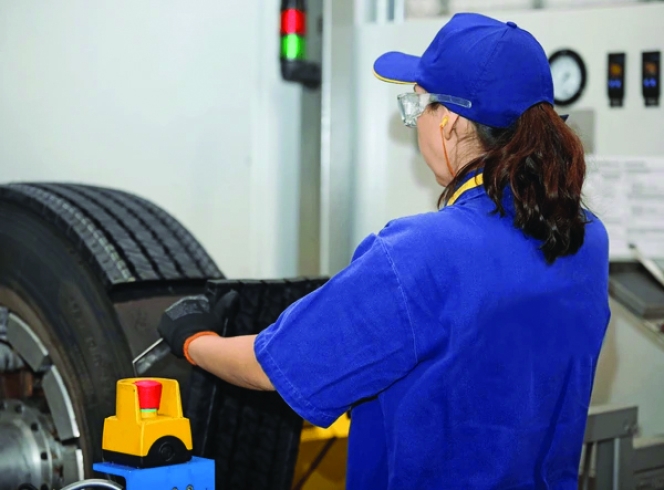
As the US Tire Manufacturers Association (USTMA) prepares for 2025 under a new administration and Congress, President and CEO Anne Forristall Luke shares insights into the industry’s priorities and recent achievements. From advancing sustainability through innovative research to advocating for updated regulations and expanding domestic retreading, USTMA is focused on driving economic growth, safety and environmental progress.
In this interview, Luke highlights the importance of collaboration with policymakers and stakeholders, detailing how the tyre industry is addressing key challenges while positioning itself as a leader in innovation and sustainability.
With a new president and Congress in place, the US Tire Manufacturers Association (USTMA) is preparing for a potential shift in regulatory priorities and legislative focus. The incoming administration may initiate a regulatory pause to assess existing policies, a move USTMA sees as an opportunity for constructive engagement.
 “This offers the tyre industry an avenue to engage with fresh faces and perspectives within the administration and Congress, fostering a dialogue about the tyre industry’s key issues,” thinks Anne Forristall Luke, USTMA president and CEO. “USTMA looks forward to collaborating with the new administration and Congress and the opportunity to highlight how smart, balanced policies can drive innovation, sustainability and growth within the US tyre manufacturing sector.”
“This offers the tyre industry an avenue to engage with fresh faces and perspectives within the administration and Congress, fostering a dialogue about the tyre industry’s key issues,” thinks Anne Forristall Luke, USTMA president and CEO. “USTMA looks forward to collaborating with the new administration and Congress and the opportunity to highlight how smart, balanced policies can drive innovation, sustainability and growth within the US tyre manufacturing sector.”
USTMA anticipates collaborating with the new administration and Congress to advance initiatives that align with the industry’s priorities. “As the association looks to 2025, its efforts will continue to centre on three key themes: innovation, sustainability and safety,” adds Luke.
USTMA aims to build relationships and advance its advocacy objectives during the 119th Congress as the Trump administration takes office. However, Luke adds that the association cannot predict the new administration’s specific policies; it remains committed to advancing its legislative priorities. These include advocating for updated National Highway Traffic Safety Administration (NHTSA) rules on consumer tyre information and performance standards, modernising tyre testing regulations, addressing potential trade and tariff issues, expanding sustainability efforts and supporting domestic manufacturing job creation.
USTMA also intends to working directly with state governments to address policy and regulatory issues where state action may arise in response to perceived gaps in federal policies.
Looking back
The year 2024 was an active period for the US tyre industry, marked by significant progress advocating for several priorities focused on enhanced road safety, tyre innovation, environmental stewardship and domestic jobs in the manufacturing sector, as per Luke.
The US tyre manufacturing industry generates an annual economic impact of USD 170.6 billion and directly provides more than 291,000 jobs across manufacturing, distribution and retail sectors. Additionally, the sector supports over 510,000 jobs through supplier and induced activities, contributing to a total of more than 801,000 jobs nationwide.
“In 2024, despite challenges such as the ongoing impact of interest rate fluctuation and inflation, post-election and geopolitical uncertainty, the tyre industry remains resilient, continually adapting to market dynamics and technological advancements to sustain its vital role in the US economy,” said Luke.
Leadership and collaboration
Luke empathises on the importance of partnerships and leadership to drive progress. Luke adds, “Achieving meaningful progress on a complex and ambitious series of goals requires strong leadership and deep collaboration to succeed. We view 2025 as a year full of opportunities to build on a rich ecosystem of partnerships with stakeholders.”
USTMA has outlined several key areas of focus for the upcoming year. Chief among them are sustainability leadership, advancing innovation through research, collaborative policy and regulatory engagement, creating economic impact and working with a new administration and a new Congress in 2025.
Collaborative efforts
Luke stresses the organisation’s commitment to working with state and federal policymakers and stakeholders across the tyre recycling value chain.
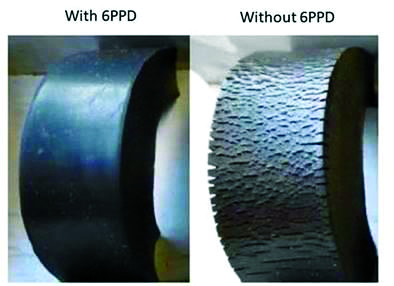
Another major initiative is advancing innovation through research, particularly in the development of sustainable alternatives to 6PPD, a chemical widely used to preserve tyre performance. The 6PPD Alternatives Analysis Consortium, spearheaded by USTMA, will move into its second stage in 2025, evaluating potential effective and environmentally sustainable alternatives.
USTMA members use a chemical additive called 6PPD to help tyres resist degradation and cracking, which is crucial for driver and passenger safety. In December 2020, researchers from the University of Washington and the Washington Stormwater Center published a report identifying a transformation product of 6PPD, called 6PPD-quinone, which they concluded is toxic to coho salmon and may be contributing to urban runoff mortality syndrome in the species. Earlier studies had not identified this substance.
In response, USTMA led the formation of a more than 30-member consortium to work transparently and collaboratively with California regulators and stakeholders to find a potential alternative to 6PPD that would protect both motorists and the environment.
“That work, and our collaboration with federal and state regulators, legislators, researchers and other interested stakeholders, will continue in 2025,” adds Luke.
Retreading
Commercial tyre retreading offers significant opportunities to expand domestic manufacturing, create American jobs, and promote sustainability. Retreading benefits not only large manufacturers but also small, independent businesses. In the US, most retread facilities are small operations, employing between 10 and 60 workers, and are often located in smaller towns and rural communities.
“By promoting investments in tyre retreading, the tyre industry aims to strengthen these small businesses, enabling them to grow, hire more workers and play a vital role in their communities. Increased demand will help these shops thrive, ensuring their longevity and supporting local economies across the country,” says Luke.
USTMA has prioritised domestic manufacturing of retreaded tyre for commercial vehicles to boost sustainability and create American jobs. The retread sector, employing over 51,000 Americans, is the largest remanufacturing sector in the US; commercial tyre retreading offers an effective way to recycle tyres, providing numerous economic and environmental benefits. Beyond job creation, retreading reduces energy consumption, CO2 emissions, raw material usage and tyre disposal challenges.
“The US Congress has an opportunity to increase domestic retreaded tyre demand by requiring the use of these tyres in the federal fleet. USTMA will continue to advocate for expanding this crucial industry to create more well-paying jobs, allowing domestic workers to contribute to the local economy,” says Luke.
Recycling
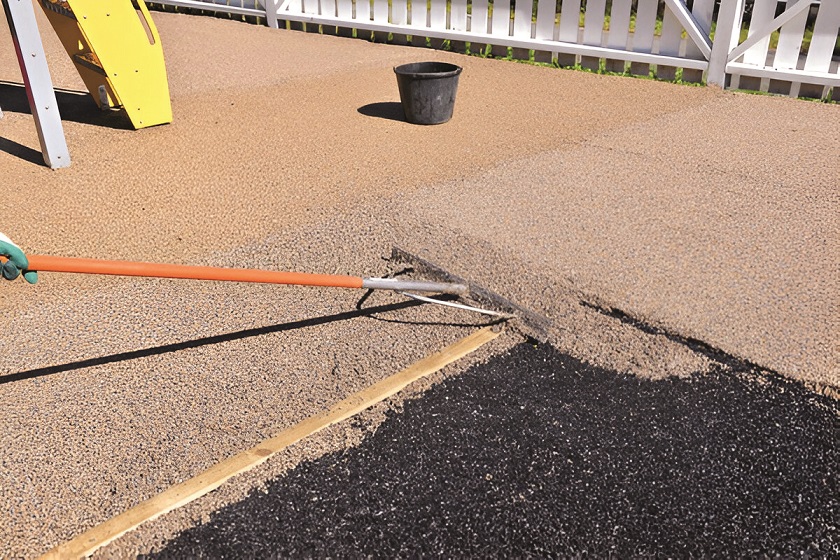
USTMA is prioritising sustainable solutions for end-of-life tyres. For nearly three decades, the association has worked with stakeholders to promote tyre recycling and advocate for supportive regulations. “Our goal is that 100 percent of end-of-life tyres will enter sustainable, circular end-use markets. This remains a top focus area for us heading into 2025,” tells Luke.
Use of recycled tyres in road construction is increasing, according to USTMA’s 2023 End-of-Life Tire Management Report. The use of rubber-modified asphalt (RMA) has grown 17 percent since 2021. USTMA sees potential for further growth in this area, thanks to recent federal infrastructure legislation. “We continue to advocate for increased investment and expansion in these areas while also pushing for greater focus on domestic retreading of commercial tyres. Particularly, USTMA has called on Congress to fund research and demonstration projects using Tire Derived Aggregates (TDA) in federal state and local construction projects,” says Luke.
As per Luke, shredded tyres can be used in various construction projects, including road embankments and stormwater systems. The association advocates for the use of RMA in federal road projects, citing its cost-effectiveness and environmental benefits.
The Tire Recycling Foundation (TRF), a joint initiative of the United States Tire Manufacturers Association (USTMA) and the Tire Industry Association (TIA), has been launched to expand markets for end-of-life tyre (ELT) and promote tyre recycling research.
The foundation aims to secure funding and allocate grants for research, education, intervention and demonstration projects addressing critical gaps in the US tyre recycling supply chain. A key focus is accelerating the adoption of RMA. Luke explains,” USTMA will continue to emphasise that collaborative efforts across the tyre recycling value chain must continue to fully eliminate illegal and abandoned tyre stockpiles and create sustainable, circular markets for ELTs, and this effort will be a focus of USTMA going forward.”
Smooth supply of NR
Natural rubber remains a key component in tyre production, but the industry is making strides in integrating modern, sustainable materials. USTMA continues to advocate for developing a domestic natural rubber supply, including alternatives like guayule, taraxacum kok-saghyz (TKS) or dandelion rubber. These efforts have already resulted in successful experimental tyres, highlighting the potential of these sustainable sources.
- United Nations Economic Commission for Europe
- UNECE
- Jean Rodriquez
- Working Party on Noise and Tyres
- GRBP
Global Tyre Standards
- By Gaurav Nandi
- December 08, 2025
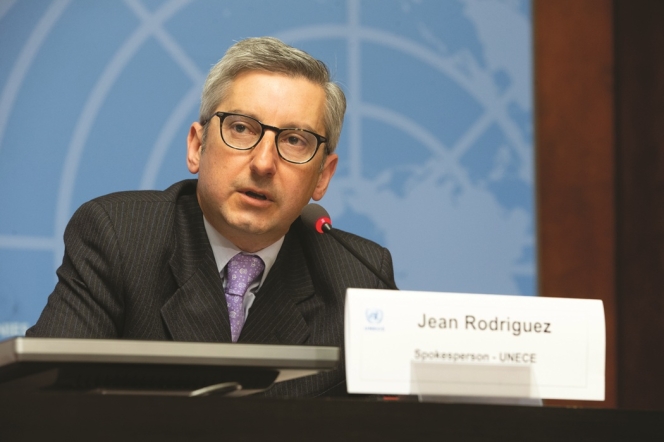
In a discussion with Tyre Trends, Chief of the United Nations Economic Commission for Europe (UNECE) Information Unit Jean Rodriguez detailed how the Working Party on Noise and Tyres (GRBP) is driving international regulations on tyre safety, noise and sustainability. From pioneering micro-plastic emission measurement to strengthening wet-grip requirements and updating studded and retreaded tyre rules, Rodriguez emphasised UNECE’s role in shaping a harmonised global framework that balances consumer safety with environmental protection.
What is the role of the Working Party on Noise and Tyres (GRBP) within UNECE?
As one of the six subsidiary bodies of the World Forum for Harmonisation of Vehicle Regulations, hosted by UNECE, the Working Party on Noise and Tyres continues to spearhead globally harmonised standards through UN Regulation No. 117, covering tyre rolling resistance, noise, wet grip and, with recent developments, abrasion measures. These UN Regulations form the backbone of safety and environmental tyre specifications adopted by numerous countries and a substantial share of tyre producers globally.
What were the key regulatory changes between 2022 and 2025?
In early 2024, the Working Party adopted the first-ever methodology to measure particle emissions from tyres, critical for tracking micro-plastic emissions via two protocols including real-world 8,000 kilometres convoy tests and 5,000 kilometres rolling-drum lab tests. These are slated for integration into a new UN Regulation by September 2025 for passenger tyres, expanding into heavier vehicle categories (C2, C3) into 2026 and 2027.
Once in force, these regulations will contribute to significantly reducing micro-plastic pollution. In 2016, tyre abrasion was estimated to represent 78 percent of the 1.3 million metric tonnes of microplastics entering the ocean.
The UNECE methodology to measure particle emissions from tyres will become the reference methodology of the Euro 7 proposal of the European Union. Moreover, EU tyre regulation and labelling covering noise, wet grip, rolling resistance and environmental transparency build directly on UNECE’s standards.
How has UNECE addressed tyre safety at legal minimum tread depth?
GRBP introduced requirements ensuring that tyres at the legal minimum tread depth (1.6 millimetres) retain a minimum wet-grip level relative to new tyres. This is a shift towards safety and sustainability by permitting consumers to drive worn tyres safely, potentially reducing waste. It obliges manufacturers to design tread compounds and patterns that preserve wet performance over the tyre’s life, not just when new.
What regulations were introduced for studded tyres in 2022?
In September 2022, a new UN Regulation to cover performance requirements and marking of studded tyres entered into force to increase road safety by introducing harmonised snow grip requirements for studded tyres. It simplified the legislative situation in several countries that allowed the usage of studded tyres on public roads, introduced strict requirements and procedures for testing their snow grip and allowed consumers to benefit from more coherent winter tyre markings.
What additional areas has UNECE been working on to align safety and environmental goals?
By refining noise standards, updating testing protocols and promoting tyre lifecycle efficiency, UNECE is steadily shaping regulations to match environmental and safety objectives. This includes work on enhanced noise testing for tyres (UN Regulation No. 117) and motorcycles (UN Regulation No. 41) and vehicle alert systems (UN Regulation No. 138/51)
How does UNECE ensure global relevance, transparency and participation in its work?
All this work in setting technical specifications testifies to UNECE’s high relevance in providing a global harmonisation framework. Its expanding scope, especially in environmental dimensions such as micro-plastic emissions, is helping it maintain policy leadership and normative force, shaping tyre safety, noise and environmental performance worldwide.
A very important aspect of UNECE work is that it prevents fragmentation of the tyre regulatory landscape. GRBP is open to governmental experts from any member country of the United Nations and to any regional economic integration organisation set up by member countries of the United Nations including experts of governmental organisations and non-governmental organisations (NGOs).
UNECE provides secretarial support to WP.29 and its working parties, facilitating negotiations between contracting parties to the 1958, 1997 and 1998 agreements. More than 100 experts participate in the sessions of GRBP and all documents considered by GRBP are available in the public domain.
What are UNECE’s priorities going forward to support safety and the circular economy?
Leveraging its technical authority and norm-setting capacities, UNECE is uniquely positioned to foster a globally harmonised tyre labelling framework that covers rolling resistance, wet grip and, for the first time, tyre abrasion. This framework promotes consistency, environmental protection, consumer transparency and ultimately supports worldwide regulatory alignment.
At its session in September 2025, GRBP will consider the proposal for a new UN Regulation on the uniform provisions concerning the approval of tyres with regard to abrasion performance.
UNECE is also updating UN Regulations no. 108 (passenger car/towed vehicle Retreaded tyres), 109 (commercial vehicle retreaded tyres) and 172 (snow performance of retreaded tyres) to ensure retreaded tyres meet the same safety standards as new tyres, even in challenging winter conditions but in a way that makes regulatory processes smoother and more conducive to circular economy practices.
Trelleborg Tires Retains Crown As Brazil's Best Agriculture Tyre
- By TT News
- December 07, 2025

For the second consecutive year, Trelleborg Tires has earned the prestigious title of Best Agriculture Tyre at the 22nd Visão Agro Brazil Awards. This 2025 accolade, presented during a ceremony in Ribeirão Preto, highlights the company’s dedicated role in advancing Brazilian agribusiness through technological leadership and a commitment to sustainable practices. The award was received on behalf of the company by Fábio Metidieri, Agri Sales Director for Yokohama TWS Brasil.
Central to this achievement is Trelleborg’s ongoing innovation, particularly the expansion of its ProgressiveTraction technology within the TM tyre series. This engineering, featured in models from the row-crop TM600 to the high-horsepower TM1000, utilises a dual-edge lug design. The tread operates progressively on the soil to enhance traction, promote self-cleaning and minimise vibration. The resulting benefits include improved operational efficiency, increased tyre durability and superior soil protection, directly supporting farmers’ goals for greater productivity and environmental stewardship.
The company’s deep roots in Brazil, supported by a specialised local team, rigorous field testing and strong manufacturer partnerships, ensure its solutions are finely tuned to regional demands. This local infrastructure allows for responsive technical service and keeps product development closely connected to the practical challenges faced by the agricultural sector. The Visão Agro Brazil Awards, judged by a panel of industry executives and researchers, serve as a recognised benchmark for innovation and performance, making this recognition a significant testament to Trelleborg Tires’ impact on the country’s farming landscape.
Metidieri said, “Receiving this award at such a prestigious event once again reinforces our commitment to Brazilian agriculture. Our goal is to keep advancing in technology and field performance, ensuring that every Trelleborg tyre delivers real value – helping farmers operate more efficiently, sustainably and profitably. This award reflects the trust placed in our team and our products by professionals throughout the sector. It strengthens our commitment to delivering technologies that address local challenges and help shape the future of Brazilian farming.”
Premium Makeover
- By Sharad Matade
- December 05, 2025
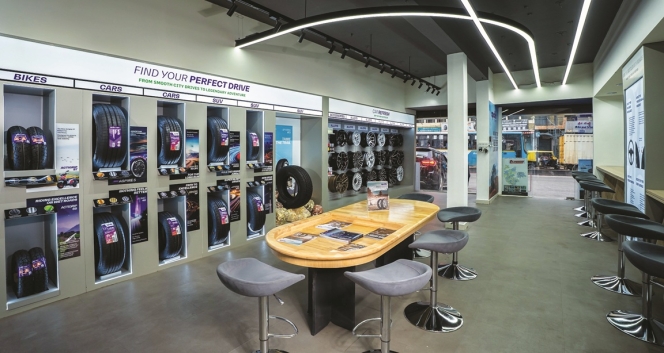
India’s tyre retail industry is undergoing a dramatic makeover, moving far beyond the cluttered workshops and transactional buying of the past. Fuelled by rising demand for premium vehicles, digital-first customers and stronger export momentum, tyre makers are transforming retail spaces into sleek, immersive experience centres. What was once a routine utility purchase is rapidly evolving into a premium, advisory-led mobility experience designed for a new generation of motorists.
India’s tyre retail scene is shifting gears, leaving behind the era of crowded workshops and impersonal counters. In their place, manufacturers are rolling out sleek, thoughtfully designed, tech-powered spaces that echo the luxury of high-end car showrooms. What started as a few bold pilots in big cities has quickly become the go-to playbook for tyre brands eager to win over a new generation of savvy, comfort-loving, digital-first customers.
From urban to rural areas, this transformation reveals a profound change in how Indians approach mobility. Today’s motorists – especially those behind the wheel of SUVs, luxury sedans and electric cars – want more than just a tyre swap. They crave expert advice, a polished atmosphere and a shopping experience that reflects the elegance of their vehicles. Once a utilitarian afterthought, tyre retail is now emerging as a coveted part of the automotive journey.
Strong OEMs and replacement demand in both domestic and export markets underpin the transition.
In FY 24-25, tyre exports from India surged by nine percent year-on-year to INR 251 billion, according to data released by the Ministry of Commerce. With an estimated annual turnover of INR 1 trillion and exports exceeding INR 250 billion, the Indian tyre industry stands out as one of the few manufacturing sectors in the country with a high export-to-turnover ratio.
Though tyre exports have hit a speed bump due to higher US tariffs on select categories of Indian tyres compared to those of competing nations, the long-term prospects for the Indian tyre industry remain strong. According to a joint report by ATMA and PwC India titled ‘Viksit Bharat 2047: Vision and Roadmap for the Indian Tyre Industry’, India’s tyre production volumes are projected to grow nearly fourfold by 2047, while industry revenues are expected to expand almost 12 times to about INR 13 trillion.
Against this backdrop, tyre makers are modernising aggressively to retain customers and build a more profound emotional affinity. The broad shift is visible in how retailers are reinventing their spaces. Lounges with crafted lighting, upholstered seating, minimalist décor and large digital walls are replacing traditional steel racks and dusty counters. Informational murals and heritage display trace decades of tyre innovation, strengthening brand storytelling. Stores increasingly feature curated experience zones where customers can explore tyre technologies, EV-compatible profiles, eco-friendly materials and performance characteristics through visual displays and interactive tools.
A clear sign of this trend is the rise of personalised, advisory-led engagement, replacing the old dependence on technicians. Retailers now profile driving habits, terrain usage, daily distance and vehicle type to recommend tyres customised to each consumer’s pattern. This service-led model is shifting the customer’s mindset from price-first decision-making to long-term value evaluation.
The new premium outlets are designed to deliver a lifestyle-driven, hospitality-grade experience rather than a traditional tyre shop visit. Customers receive personalised mobility recommendations tailored to their vehicle, driving style and needs, supported by smart service innovations like intelligent product selection, quick-fit services and digital scheduling. The space also acts as a community hub for driving enthusiasts, creating a connected ecosystem around the brand. With lounge-style comfort, immersive storytelling and specialised tyre and service packages for luxury and performance vehicles, the outlet blends convenience, premium care and brand-centric offerings into an elevated customer experience.
“Customer experience at the point of sale is another branding exercise poised to change buyer characteristics. Multi-brand outlets often commoditise the tyre-buying experience. That’s why companies are launching exclusive brand outlets with curated customer experiences. Over the next decade, new delivery models will emerge,” said Kavan Mukhtyar, Partner and Leader – Automotive, PwC India.
Apollo Tyres articulates this change as a move towards lifestyle-led retailing. Its new super-premium outlets have been built not as showrooms but as emotionally resonant spaces.

Udyan Ghai, Group Head of Marketing at Apollo Tyres, explained that the company’s new retail architecture is anchored in long-term strategic priorities: “Our move to a lifestyle-led, immersive tyre retail format is driven by our own desire for premiumisation and category leadership. We are looking at elevating tyre retail in India by setting new benchmarks and shifting from commodity selling to a premium, lifestyle-driven experience.”
He said the brand aims to ‘emotionally engage with customers, offer tailored solutions, build a community of driving enthusiasts and tap into premium segments – all while delivering a differentiated, modern retail experience’.
Ghai believes retail ambience plays a decisive role in influencing perception. “A relaxed and well-designed lounge signals comfort, trust and premium value,” he said, adding that such environments elevate tyres from a mundane requirement to a core element of vehicle care and identity.
Digital transparency, he believes, is the second pillar of modern tyre retail. “Digital systems ensure transparency and help demystify tyre selection – tread patterns, speed ratings, durability and fitment. Consumers feel less dependent on a technician’s word and more in control, which boosts their confidence and perceived fairness,” Ghai said.
Customers today are inundated with choices, and digital systems, he said, turn tyre buying into an ‘informed, personalised decision’, comparable to selecting a smartphone, a pair of performance shoes or even a detailed insurance plan. According to Ghai, this new retail model is ‘a strategic investment in the future of mobility retail’, designed to be scalable and to support community-building events, workshops and enthusiast interactions. As India moves towards EVs and connected cars, he said these premium outlets will provide EV-focused tyre expertise, interactive digital tools and personalised recommendations that appeal to younger, digitally savvy motorists.
CEAT shares a similar philosophy. Its national retail revamp focuses heavily on digital immersion, consistent messaging and design-led layouts. Lakshminarayanan B, the company’s Chief Marketing Officer, said the modernised CEAT Shoppes are fundamentally reshaping the category.

“The modern layouts and digital integration in CEAT Shoppes are revolutionising the tyre-buying experience, making it more experiential and customer-centric,” he said, adding that these updated outlets elevate the experience, build trust through uniform communication and drive decisions by reducing ambiguity around features and value.
Lakshminarayanan highlighted CEAT’s attempt to harmonise customer experience across demographics: “The approach in urban markets through premium stores, product offerings and services is to create access and aspiration for premium customers. The same is replicated in upcountry markets also.”
The CEAT Executive said the company is building for a future where personalisation will be the defining characteristic of tyre retail. “CEAT is focused to drive the future of tyre retail through end-to-end personalisation,” he said.

As experiential retail takes hold, service portfolios inside tyre stores are expanding faster than ever. Advanced wheel balancing, laser-driven alignment systems, nitrogen inflation, premium alloy wheel installations, EV-oriented tyre consultations, digital appointment scheduling and real-time tyre-health diagnostics are now standard. Many outlets also provide car detailing, interior cleaning, ceramic coating, PPF application, brake checks, battery inspections and multi-point vehicle health reports, making them full-fledged mobility centres.
Global players have pushed the envelope even further. Michelin’s 25,000-square-foot Experience Store in Nashik features a heritage wall and innovation displays showcasing electric mobility, materials science and environmental responsibility. It houses precision wheel-alignment bays, detailing studios, and accessory galleries. “We are proud to unveil Michelin’s first Experience Centre in India. The sole purpose of this store is to go beyond traditional tyre retail and provide customers with an immersive experience of the brand,” said Shantanu Deshpande, Managing Director of Michelin India.
Continental Tyres is also strengthening India’s premium retail ecosystem through its CPD outlets, which include ambient lounges, diagnostic equipment, premium alloy wheels and digitally enabled guidance. “With our new CPD store in Indore, we bring Continental’s promise of safety, innovation and comfort closer to Madhya Pradesh’s clients,” said Samir Gupta, Managing Director of Continental Tyres India. He added that the brand’s ‘In the Market, For the Market’ approach is central to its retail expansion strategy.
Even in rural markets, tyre retail is becoming more formalised, structured and service-oriented. JK Tyre’s ‘Steel Wheels’ format is targeted at towns with populations under 100,000 and offers standardised layouts, value-added services, best-in-market pricing and instant claim facilities. “Our Rural expansion programme will help us reach the interiors of the real Bharat that is economically vibrant but often underserved. We are not just building retail points; we are also enabling entrepreneurship and access,” said Managing Director Anshuman Singhania.
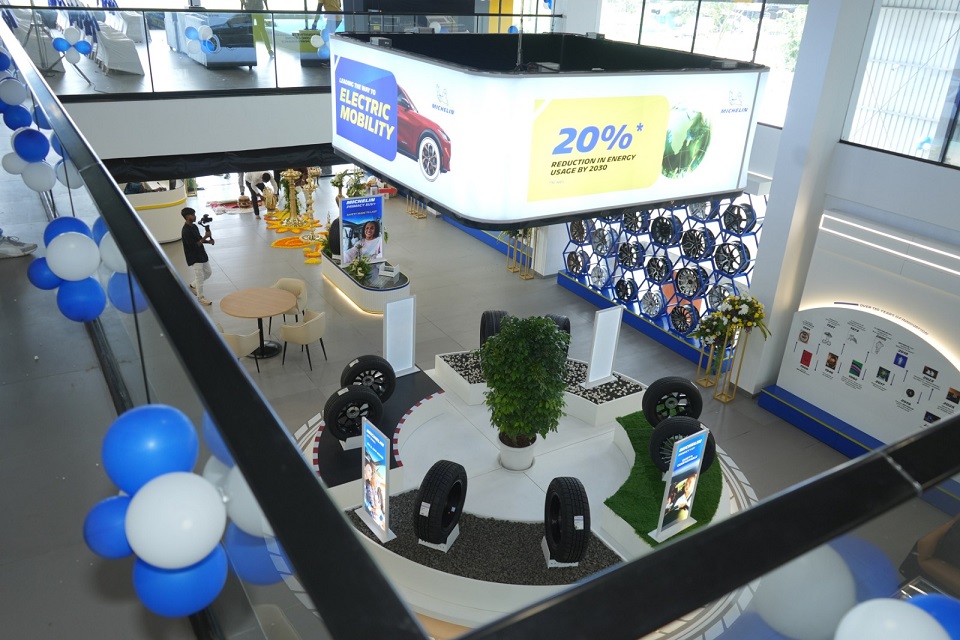 Together, these developments mark a decisive shift in how tyre brands engage customers. Tyre stores are increasingly functioning as lifestyle environments, designed for comfort, informed decision-making, personalisation, transparency and community. The industry is moving away from a product-first mindset to a customer-experience-led philosophy.
Together, these developments mark a decisive shift in how tyre brands engage customers. Tyre stores are increasingly functioning as lifestyle environments, designed for comfort, informed decision-making, personalisation, transparency and community. The industry is moving away from a product-first mindset to a customer-experience-led philosophy.
As premium cars, SUVs and EVs become mainstream, and as younger motorists prioritise digital empowerment and ambience, tyre retailers are aligning with these new expectations. India’s tyre makers are building a retail landscape where experiential engagement, technology integration, service breadth and emotional connection define long-term brand success.
For an industry long anchored in grease, metal and functionality, the transformation is profound. Tyre retail in India is no longer just about fitment; it is becoming a premium mobility experience, curated for a generation that demands clarity, comfort and an elevated relationship with every aspect of vehicle ownership.
Kumho Tire To Build First European Plant In Poland With $587mln Investment
- By TT News
- December 05, 2025
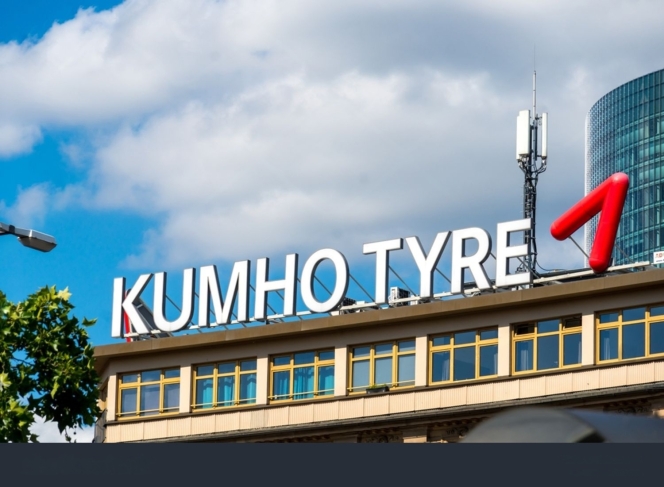
Kumho Tire will establish its first European manufacturing plant in Poland’s Opole region as the South Korean company seeks to expand its position in one of the world’s largest tyre markets.
The group said the factory is scheduled to begin initial operations in August 2028, subject to investment approval and licensing. Kumho plans to produce 6m units annually in the first phase and expand capacity in line with demand. Total planned investment is USD 587 million.
Kumho has spent recent years evaluating multiple European locations, including Poland, based on logistics, labour availability, infrastructure, market access and investment incentives. The company said Opole was selected as the optimal site owing to supply-chain stability within the EU and the region’s supportive operating conditions.
Europe accounts for about a quarter of global tyre consumption and is home to several major automotive manufacturers. The region represented roughly 26.6 per cent of Kumho’s sales last year. The company has previously relied on exports to serve European customers, which it said limited its competitiveness in the market.
The new plant is intended to strengthen Kumho’s ability to supply high-value-added products, including high-performance and larger-diameter tyres, to European vehicle makers.
Kumho currently operates eight production sites across South Korea, China, the US and Vietnam, with combined annual output of 65 millionunits. The Polish plant will complete what the company describes as a production network spanning Asia, Europe and North America.
Jung Il-taek, Kumho Tire’s Chief Executive, said: “The European market occupies a very important strategic position in the global tire industry,” adding that “Kumho Tire will go beyond simple exports and dramatically enhance premium brand value by strengthening quality and service competitiveness through local European production and supply.”







Comments (0)
ADD COMMENT